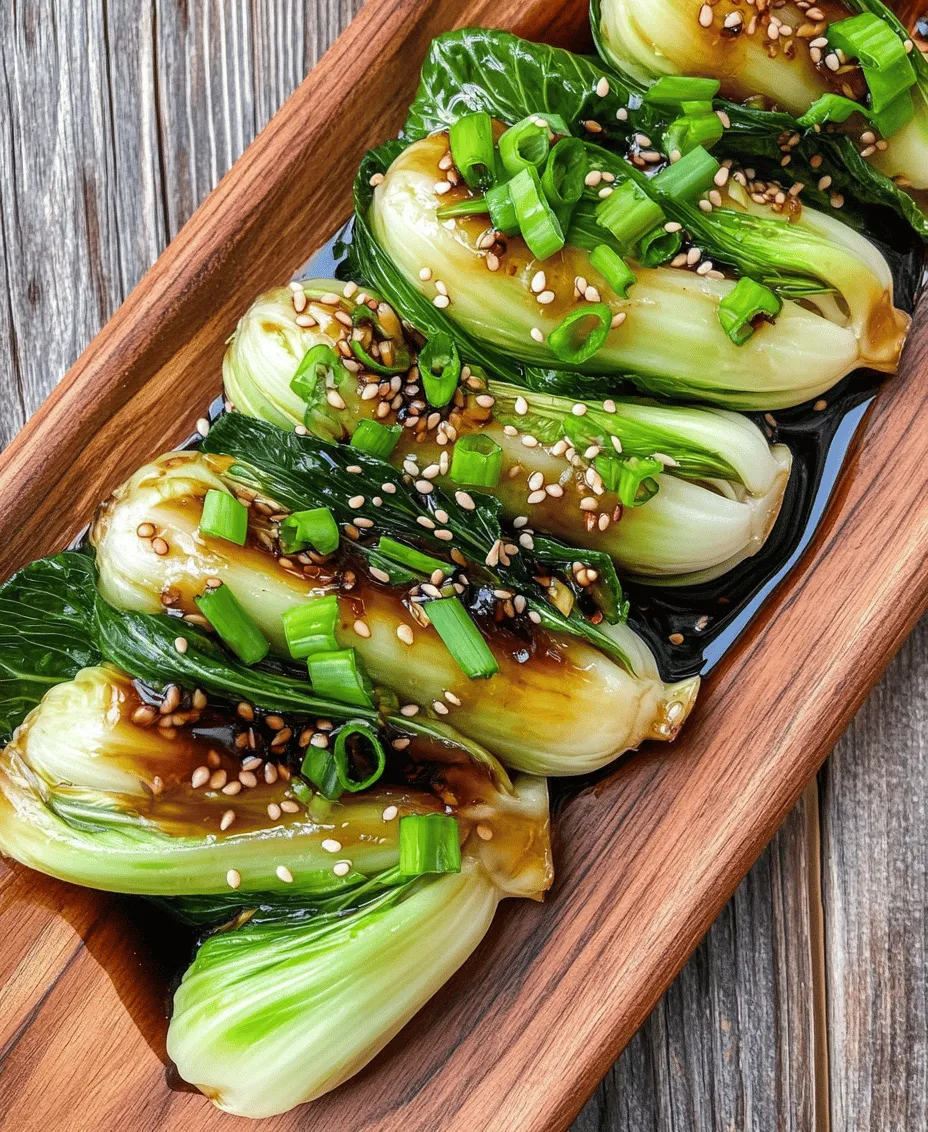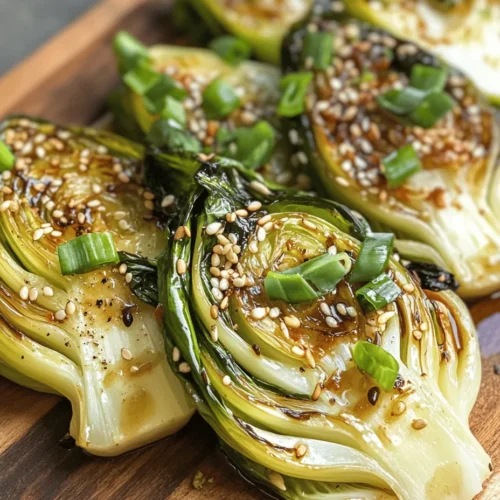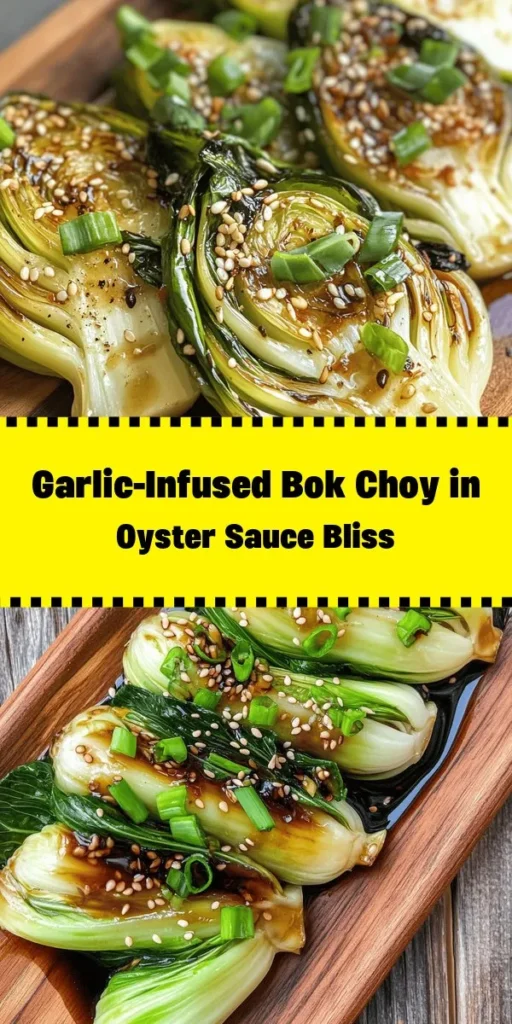Introduction
Bok choy delight in garlic oyster sauce is a delightful vegetable dish that highlights the fresh, crispy texture and mild flavor of bok choy, enhanced by a rich and savory sauce. This dish is not only visually appealing with its vibrant green hues but also bursts with flavor, making it an excellent addition to any meal. As we strive for a balanced diet, incorporating vegetables like bok choy into our meals is essential. Bok choy is a powerhouse of nutrients, offering a range of health benefits that contribute to overall wellness. This article will delve into the wonderful world of bok choy, its nutritional advantages, and key ingredients that elevate this dish to new heights.
Exploring Bok Choy
Bok choy, also known as Chinese cabbage, is a leafy green vegetable that is widely used in Asian cuisine. Originating from China, this versatile vegetable has become popular worldwide for its crisp texture and mild flavor, which pairs well with a variety of ingredients. Bok choy is typically characterized by its dark green, tender leaves and thick white stems, which provide a satisfying crunch when cooked.
There are several varieties of bok choy, each with unique characteristics. The most common types include the standard bok choy, which features broad, dark green leaves with a white stem, and baby bok choy, which is smaller and more delicate, making it perfect for quick cooking or salads. Another variety is Shanghai bok choy, which has a more rounded leaf shape and a slightly sweeter taste. Regardless of the type, bok choy is a versatile ingredient that can be enjoyed in soups, stir-fries, and salads.
Nutritionally, bok choy is an excellent choice for health-conscious individuals. It is low in calories yet rich in vitamins and minerals. A single cup of cooked bok choy provides an impressive amount of vitamin K, which is vital for bone health and blood clotting. Additionally, bok choy is a great source of vitamin C, which supports immune function and skin health. It also contains significant amounts of calcium, potassium, and fiber, making it a valuable addition to any diet.
Key Ingredients Breakdown
To create a delicious bok choy delight in garlic oyster sauce, it’s essential to understand the key ingredients that contribute to this dish’s distinctive flavor and health benefits. Here’s a detailed breakdown of each ingredient:
Oyster Sauce
At the heart of this recipe is oyster sauce, a staple in many Asian kitchens. Made from oyster extracts, sugar, and soy sauce, this thick, dark sauce adds a rich umami flavor that enhances the overall taste of the dish. It provides a savory depth that complements the freshness of bok choy, creating a harmonious balance of flavors. Oyster sauce is not only delicious but also versatile; it can be used in stir-fries, marinades, and even as a dipping sauce.
Soy Sauce
Another key ingredient in this recipe is soy sauce, a fermented condiment that is a cornerstone of Asian cooking. Soy sauce adds a salty, savory flavor that enhances the taste of the vegetables. It contains essential amino acids and has antioxidant properties, making it a healthier alternative to table salt. Low-sodium versions are available for those watching their sodium intake, ensuring that everyone can enjoy the benefits of this flavorful ingredient.
Sesame Oil
Sesame oil is used sparingly in this recipe, but its impact is profound. With its distinctive nutty aroma, sesame oil not only enhances the flavor of the dish but also provides health benefits. It is rich in antioxidants and healthy fats, which can help improve heart health and reduce inflammation. A drizzle of sesame oil at the end of cooking can elevate the dish, adding a final touch of flavor.
Garlic and Ginger
Garlic and ginger are aromatic powerhouses that are often used together in Asian cooking. Both ingredients are known for their numerous health benefits. Garlic has been linked to improved heart health and immune function, while ginger is praised for its anti-inflammatory properties and ability to aid digestion. In this recipe, minced garlic and ginger are sautéed to release their aromatic qualities, infusing the dish with a warm, inviting fragrance that stimulates the senses.
Vegetable Oil
Vegetable oil plays a crucial role in the stir-frying process. It is used to create a high-heat environment that allows the bok choy to cook quickly while retaining its crisp texture. The choice of oil is important; neutral oils like canola or sunflower oil work best, as they do not overpower the other flavors in the dish. Using the right amount of oil ensures that the bok choy is properly sautéed without becoming greasy.
Cornstarch
Finally, cornstarch is essential for thickening the sauce in this recipe. When combined with a bit of water, it creates a slurry that will help the sauce cling to the bok choy, providing a glossy, flavorful coating. Cornstarch is a common thickening agent in many cuisines, and for those looking for alternatives, arrowroot powder or tapioca starch can be used in its place.
Preparation Steps for Bok Choy Delight
To prepare bok choy delight in garlic oyster sauce, it is crucial to start with fresh, clean ingredients. Here is a step-by-step guide on how to prepare bok choy for cooking:
Cleaning and Prepping Bok Choy
Begin by selecting fresh bok choy from your local grocery store or farmers’ market. Look for bright green leaves and firm stems. Once you have your bok choy, rinse it thoroughly under cold water to remove any dirt or grit. It’s important to separate the leaves from the stem by slicing the bok choy in half lengthwise, as the leaves and stems will cook at different rates. After cutting, give the leaves a final rinse to ensure they are clean.
Importance of Drying Bok Choy
After washing, it is essential to dry the bok choy thoroughly. Excess moisture can cause the vegetables to steam rather than sauté, leading to a less desirable texture. You can use a salad spinner to remove water or pat the bok choy dry with a clean kitchen towel. Ensuring the bok choy is dry will help achieve a perfect sauté, allowing the leaves to retain their vibrant color and crunch.
Crafting the Perfect Sauce
While the bok choy is drying, you can prepare the sauce that will bring this dish to life. In a small bowl, combine oyster sauce, soy sauce, and a splash of water. If you prefer a thicker sauce, mix in a teaspoon of cornstarch to the mixture, creating a slurry that will help thicken the sauce as it cooks. Stir in minced garlic and ginger for added flavor. Once the sauce is prepared, set it aside for later use.
By following these initial steps, you will set the stage for a delicious bok choy delight in garlic oyster sauce. This dish not only showcases the unique flavors of bok choy but also emphasizes the importance of using fresh ingredients to create a vibrant and healthy meal. As you continue with the recipe, you will discover how these simple yet flavorful components come together to create a quick and satisfying dish that is sure to impress.

Tips for Balancing Flavors in the Sauce
When preparing your Bok Choy Delight in Garlic Oyster Sauce, achieving the perfect flavor balance is essential for a delicious dish. The garlic oyster sauce should be savory with a hint of sweetness and umami. Here are some tips to help you achieve that balance:
1. Taste as You Go: Start with a small amount of sauce and gradually add more until you reach your desired flavor. This method allows you to fine-tune the sauce’s taste without overpowering the dish.
2. Add Acid for Brightness: If the sauce feels too heavy or rich, a splash of acid can cut through the flavors. Consider adding a few drops of rice vinegar or a squeeze of fresh lime juice just before serving to brighten the dish.
3. Sweetness Adjustment: If the oyster sauce is too salty or savory for your taste, adding a touch of sweetness can balance it out. A teaspoon of sugar, honey, or agave syrup can add a lovely contrast to the salty notes.
4. Herbs and Spices: Fresh herbs like cilantro or green onions can add a fresh, bright flavor to the dish. A sprinkle of sesame seeds or a dash of chili flakes can also enhance the flavor profile.
5. Umami Boost: For an extra umami kick, consider incorporating a splash of soy sauce or a teaspoon of miso paste. However, be cautious as both ingredients can increase the saltiness of the dish.
Optional Additions or Substitutions for Sauce Variations
While the Garlic Oyster Sauce is a star in this dish, you can explore various additions or substitutions to customize the flavors:
1. Soy Sauce: If you’re looking for a gluten-free option, substitute the oyster sauce with a gluten-free soy sauce or tamari. This will provide a similar savory flavor while accommodating dietary restrictions.
2. Mushroom Sauce: For a vegan alternative, use mushroom sauce instead of oyster sauce. It offers a similar depth of flavor and richness.
3. Chili Paste or Sauce: For those who enjoy a spicy kick, add a teaspoon of chili garlic sauce or Sriracha to the sauce. This will enhance the dish’s flavor while providing a delightful heat.
4. Sesame Oil: A drizzle of toasted sesame oil can add a nutty flavor to the sauce. Use it sparingly, as it has a strong taste.
Stir-Frying Techniques
Stir-frying is a fundamental cooking technique in Asian cuisine that allows for quick cooking while preserving the flavors and textures of ingredients. Here’s an overview of the stir-frying process, including essential equipment and tips for success.
Overview of Stir-Frying as a Cooking Technique
Stir-frying involves cooking ingredients quickly over high heat, typically in a wok or a large skillet. This method is highly effective for cooking vegetables like bok choy, as it retains their nutrients, color, and crunchiness while allowing flavors to meld beautifully.
Equipment Needed: Skillet vs. Wok
– Wok: A traditional choice for stir-frying, the wok has a rounded bottom, allowing for even heat distribution. It also has high sides that prevent ingredients from spilling out while tossing.
– Skillet: A large, flat-bottomed skillet can also work well for stir-frying. Ensure it has high sides to accommodate the tossing action.
Regardless of the equipment you choose, make sure it is large enough to allow for proper movement of the ingredients without overcrowding, which can lead to steaming rather than frying.
Importance of Heat and Timing in Stir-Frying
The success of stir-frying hinges on high heat and quick timing. Here’s why:
– High Heat: Using high heat ensures a quick sear, locking in flavors and juices while keeping vegetables crisp. Make sure your pan is hot before adding oil.
– Quick Timing: Stir-frying is meant to be fast-paced. Ingredients should be cut uniformly to ensure even cooking. Overcooking can lead to soggy vegetables and loss of flavor.
Detailed Instructions on the Stir-Frying Process
1. Prepare Your Ingredients: Before you begin cooking, wash and chop the bok choy into bite-sized pieces. Mince the garlic and ginger, ensuring they are ready to go as they cook quickly.
2. Heat the Wok or Skillet: Place your wok or skillet over high heat and allow it to get hot. You can test if it’s ready by adding a drop of water; it should sizzle and evaporate immediately.
3. Add Oil: Once the pan is hot, add a tablespoon of cooking oil (such as vegetable oil or peanut oil). Swirl the oil around to coat the surface.
4. Add Garlic and Ginger: When the oil is shimmering, add the minced garlic and ginger. Stir quickly for about 15 seconds until fragrant. Be careful not to burn them, as they can turn bitter.
5. Add Bok Choy: Immediately add the chopped bok choy to the pan. Stir-fry for about 2–3 minutes, tossing frequently until the greens are vibrant and just tender but still crisp.
6. Incorporate the Sauce: Pour in your prepared garlic oyster sauce and stir to coat the bok choy evenly. Cook for an additional minute, allowing the sauce to heat through and cling to the vegetables.
7. Final Toss: Give everything a final toss for about 30 seconds, ensuring the bok choy is well-coated with the sauce. Remove from heat.
How to Know When Bok Choy is Perfectly Cooked
The ideal bok choy should be bright green and just tender but still have a satisfying crunch. Overcooked bok choy will lose its vibrant color and become mushy. To test for doneness, you can taste a piece; it should be tender with a slight bite.
Serving Suggestions and Pairings
Bok Choy Delight in Garlic Oyster Sauce can be served as a side dish or a main course. Here are some excellent serving suggestions and pairings:
– Main Course Pairings: Serve this dish alongside steamed jasmine rice or quinoa for a complete meal. It pairs beautifully with protein options like grilled chicken, shrimp, or tofu for a plant-based meal.
– Side Dishes: Complement the dish with other vegetable sides such as stir-fried bell peppers, snap peas, or steamed broccoli to create a colorful and nutritious plate.
– Presentation Tips: For a visually appealing presentation, serve the bok choy in a shallow bowl, garnishing it with toasted sesame seeds and sliced scallions. A drizzle of extra sauce on top can enhance the dish’s appearance.
Health Benefits of Bok Choy Delight
Bok choy is not only delicious but also packed with health benefits, making this dish a fantastic addition to a balanced diet. Here’s a closer look at the nutritious aspects of Bok Choy Delight:
Low-Calorie Meal Option Rich in Nutrients
Bok choy is low in calories but high in essential nutrients. A one-cup serving contains only about 20 calories while providing a significant amount of vitamin C, vitamin K, and folate. This makes it an excellent choice for those looking to maintain or lose weight while ensuring nutrient intake.
Benefits of Incorporating Leafy Greens into Meals
Leafy greens like bok choy are vital for a healthy diet. They are rich in antioxidants and phytochemicals, which help combat oxidative stress and inflammation in the body. Regular consumption of leafy greens has been linked to improved heart health and a reduced risk of chronic diseases.
How This Dish Fits into Various Dietary Preferences
Bok Choy Delight in Garlic Oyster Sauce is versatile and easily adaptable to fit various dietary preferences:
– Vegan: By substituting oyster sauce with mushroom sauce or a vegan soy sauce, this dish can easily be made vegan-friendly.
– Gluten-Free: Using gluten-free soy sauce or tamari ensures the dish remains gluten-free while still delivering flavor.
– Low-Carb: Bok choy is a fantastic low-carb vegetable, making this dish suitable for those following a ketogenic or low-carb diet.
Conclusion
Bok Choy Delight in Garlic Oyster Sauce is a delightful fusion of flavors and health benefits, making it a perfect addition to your culinary repertoire. The combination of crisp bok choy, aromatic garlic, and savory oyster sauce creates a satisfying dish that can be enjoyed as a side or a main course.
This recipe encourages experimentation with bok choy, allowing you to incorporate this nutritious green into your daily cooking. Whether you’re looking for a quick meal option or a vibrant side dish, Bok Choy Delight is quick and easy to prepare, ensuring it becomes a staple in your kitchen. Embrace the deliciousness of bok choy and enjoy the myriad of flavors and health benefits it offers!



